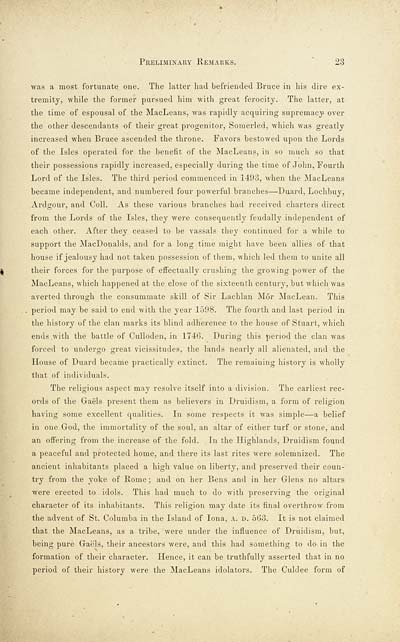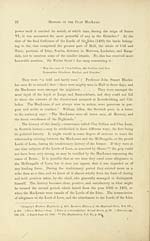History of the Clan MacLean from its first settlement at Duard Castle, in the Isle of Mull, to the present period
(29) Page 23
Download files
Complete book:
Individual page:
Thumbnail gallery: Grid view | List view

PrelixMinary Remarks. " 23
was a most fortunate cue. The latter had befriended Bruce in his dire ex-
tremity, while the former pursued him with great ferocity. The latter, at
the time of espousal of the MacLeans, was rapidly acquiring supremacy over
the other descendants of their great progenitor, Somerled, which was greatly
increased when Bruce ascended the throne. Favors bestowed upon the Lords
of the Isles operated for the benefit of the MacLeans, in so much so that
their possessions rapidly increased, especially during the time of John, Fourth
Lord of the Isles. The third period commenced in 1493, when the MacLeans
became independent, and numbered four powerful branches — Duard, Lochbuy,
Ardgour, and Coll. As these various branches had received charters direct
from the Lords of the Isles, they were consequently feudally independent of
each other. After they ceased to be vassals they continued for a wiiile to
support the MacDonalds, and for a long time might have been allies of that
house if jealousy had not taken possession of them, which led them to unite all
their forces for the purpose of effectually crushing the growing power of the
MacLeans, which happened at the close of the sixteenth century, but which was
averted through the consummate skill of Sir Lachlan Mor MacLean. Tiiis
period may be said to end with the year 1598. The fourth and last period in
the history of the clan marks its blind adherence to the house of Stuart, which
ends with the battle of Culloden, in 174(3. During this period the clan was
forced to undergo great vicissitudes, the lands nearly all alienated, and the
House of Duard became practically extinct. The remaining history is wholly
that of individuals.
The religious aspect may resolve itself into a division. The earliest rec-
ords of the Gaels present them as believers in Druidism, a form of religion
having some excellent qualities. In some respects it was simple — a belief
in one God, the immortality of the soul, an altar of either turf or stone, and
an offering from the increase of the fold. In the Highlands, Druidism found
a peaceful and protected home, and tliere its last rites were solemnized. The
ancient inhabitants placed a high value on libertj', and preserved their coun-
try from the yoke of Rome ; and on her Bens and in her Glens no altars
were erected to idols. This had much to do with preserving the original
character of its inhabitants. This religion may date its final overthrow from
the advent of St. Columba in the Island of lona, A. D. 5G3. It is not claimed
that the MacLeans, as a tribe, were under the influence of Druidism, but,
being pure Gaels, their ancestors were, and this had something to do in the
formation of their character. Hence, it can be truthfully asserted that in no
period of their history were the MacLeans idolators. The Culdee form of
was a most fortunate cue. The latter had befriended Bruce in his dire ex-
tremity, while the former pursued him with great ferocity. The latter, at
the time of espousal of the MacLeans, was rapidly acquiring supremacy over
the other descendants of their great progenitor, Somerled, which was greatly
increased when Bruce ascended the throne. Favors bestowed upon the Lords
of the Isles operated for the benefit of the MacLeans, in so much so that
their possessions rapidly increased, especially during the time of John, Fourth
Lord of the Isles. The third period commenced in 1493, when the MacLeans
became independent, and numbered four powerful branches — Duard, Lochbuy,
Ardgour, and Coll. As these various branches had received charters direct
from the Lords of the Isles, they were consequently feudally independent of
each other. After they ceased to be vassals they continued for a wiiile to
support the MacDonalds, and for a long time might have been allies of that
house if jealousy had not taken possession of them, which led them to unite all
their forces for the purpose of effectually crushing the growing power of the
MacLeans, which happened at the close of the sixteenth century, but which was
averted through the consummate skill of Sir Lachlan Mor MacLean. Tiiis
period may be said to end with the year 1598. The fourth and last period in
the history of the clan marks its blind adherence to the house of Stuart, which
ends with the battle of Culloden, in 174(3. During this period the clan was
forced to undergo great vicissitudes, the lands nearly all alienated, and the
House of Duard became practically extinct. The remaining history is wholly
that of individuals.
The religious aspect may resolve itself into a division. The earliest rec-
ords of the Gaels present them as believers in Druidism, a form of religion
having some excellent qualities. In some respects it was simple — a belief
in one God, the immortality of the soul, an altar of either turf or stone, and
an offering from the increase of the fold. In the Highlands, Druidism found
a peaceful and protected home, and tliere its last rites were solemnized. The
ancient inhabitants placed a high value on libertj', and preserved their coun-
try from the yoke of Rome ; and on her Bens and in her Glens no altars
were erected to idols. This had much to do with preserving the original
character of its inhabitants. This religion may date its final overthrow from
the advent of St. Columba in the Island of lona, A. D. 5G3. It is not claimed
that the MacLeans, as a tribe, were under the influence of Druidism, but,
being pure Gaels, their ancestors were, and this had something to do in the
formation of their character. Hence, it can be truthfully asserted that in no
period of their history were the MacLeans idolators. The Culdee form of
Set display mode to:
![]() Universal Viewer |
Universal Viewer | ![]() Mirador |
Large image | Transcription
Mirador |
Large image | Transcription
Images and transcriptions on this page, including medium image downloads, may be used under the Creative Commons Attribution 4.0 International Licence unless otherwise stated. ![]()
| Histories of Scottish families > History of the Clan MacLean from its first settlement at Duard Castle, in the Isle of Mull, to the present period > (29) Page 23 |
|---|
| Permanent URL | https://digital.nls.uk/94802231 |
|---|
| Description | A selection of almost 400 printed items relating to the history of Scottish families, mostly dating from the 19th and early 20th centuries. Includes memoirs, genealogies and clan histories, with a few produced by emigrant families. The earliest family history goes back to AD 916. |
|---|

